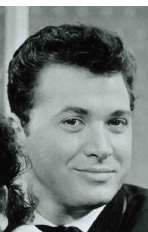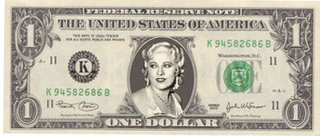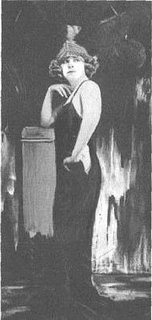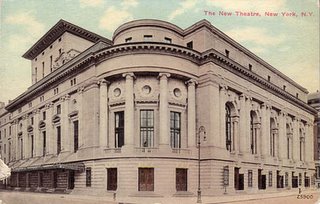 From a new biography of Mae West, here's an excerpt:
From a new biography of Mae West, here's an excerpt:Liberty belle feels the heat
by Simon Louvish
• • • • • • • • • • • • • • • • • • • • • • • • • •
• • MAE WEST ran out of takers for her exploration of society's rejects at a time when more and more people were falling over the edge to join their ranks. And there were fewer and fewer theatres available in the straitened circumstances that now had a new name: the Depression.
• • Opportunities on the New York stage were sinking fast. Even on the other side of the continent, economic woes were mounting, unemployment rising, movie attendances dropping. Hollywood studios were looking for new ideas, novelties, sensations that could revive sagging fortunes.
• • Now that the movies could talk, sing and babble, new voices were wanted, and the sassier the better.
• • Mae took time to adjust to the pace of Hollywood in 1932. Settling down at the Rossmore Apartments, Mae claimed that she found doing nothing for $5,000 a week somewhat unnerving, and the part written for her in the script she was (eventually) sent by Paramount appeared banal and unrewarding — — at least until she could rewrite the lines.
• • We now know that Mae was never doing nothing, her spare time being spent in continuous production of her notes, gag folders, and quips. But as she was to write in her autobiography: "It was a new medium, a technique I had to learn, bend to my will and forget in order to give a natural performance." The studios, Mae soon discovered, were "giant factories turning out the same length of scented tripe, dressed up with the same rubber-stamp features of large cow-like heads, mammary glands, and 10-foot-high close-ups of nostrils you could drive a Cadillac into."
• • Mae could well have been worried by these great close-ups disclosing the fact that, as some shrewd journalists had surmised, she was about to breast the 40-years-old tape rather than the official 33 marker, wondering how she could re-enact the trick that the distance of the stage and theatrical make-up enabled her to carry off.
• • She need not have worried. In 1934 Mae became the highest paid performer in the US, bar none, with an annual income, according to the press, of $399,166.
• • While her Belle of the Nineties was not as big a hit as She Done Him Wrong and I'm No Angel, these were to remain on the books as Paramount's highest grossing pictures for the early years of the 1930s.
• • But comedy was moving on, with Frank Capra's It Happened One Night, made for Columbia in 1934 with Clark Gable and Claudette Colbert, winning five Oscars and establishing a new romantic but socially more realist format.
• • And time was taking its toll on Mae, despite all her endeavours to ignore the incoming tide.
• • In 1935 when Paramount sought to re-release She Done Him Wrong and I'm No Angel, censor Joseph Breen wrote to his colleague Will Hays that "it is our judgment that no successful effort can be made to cause them to be entirely unobjectionable to the production code."
• • Just a month before, the US Customs Service had banned Mae's 1932 novel of Diamond Lil as obscene. The two movies were classified by the Production Board as class one: "Pictures which should be withdrawn immediately and not again released."
• • It was in this atmosphere that Mae laboured to produce the rest of her '30s movies, from Klondike Annie through to My Little Chickadee. The gates were shut, and all but padlocked, on Mae. World War II itself and the great shaking that it gave American life did not move Breen one inch. The code's provision that foreign nations should not be offended constrained the making of movies that would be overtly critical of Nazi Germany, or fascism in general, until the US entered the war.
• • In 1949, Breen was again writing to Paramount, this time to executive Luigi Luraschi: "With further reference to the question of the reissue of the Mae West 1933 production I'm No Angel ... no good will accrue to the industry among right-thinking people with a release of a Mae West picture. On the contrary, it would appear to me that we would expose ourselves to the charge that we were 'letting down the bars'; that we were again making 'filthy pictures', as was the charge levelled against the industry, from a thousand sources back in 1933-34."
• • And for those who still dreamed of movies that nevertheless challenged the status quo, the era of senator Joseph McCarthy and the Hollywood Ten would soon provide further deterrence. Without Breen's zealous witch-hunting in the '30s, McCarthyism might not have had so potent a precedent to root out transgression in American cultural life.
• • Mae was to make one wartime comeback movie, The Heat's On, in 1943. But at the beginning of the '40s her creative energies were focused on her return to the stage. . . .
• • Edited extract from a new biography — — Mae West: It Ain't No Sin by Simon Louvish [UK: Faber & Faber]
Condensed by the editorial staff of The Australian: http://www.theaustralian.news.com.au/
________________________________
Source:http://maewest.blogspot.com/atom.xml
Mae West
• • Photo: Mae West (born 1893 in Brooklyn, NY)
NYC
Mae West.




















